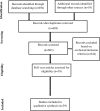Serious Suicide Attempts: Systematic Review of Psychological Risk Factors
- PMID: 29563886
- PMCID: PMC5845877
- DOI: 10.3389/fpsyt.2018.00056
Serious Suicide Attempts: Systematic Review of Psychological Risk Factors
Abstract
Background: One of the main obstacles in studying suicide risk factors is the difference between cases in which the individual died by suicide and those in which the individual engaged in suicidal behavior. A promising strategy that overcomes this obstacle is the study of survivors of serious suicide attempt (SSA), i.e., an attempt that would have been lethal had it not been for the provision of rapid and effective emergency treatment. Serious suicide attempters are epidemiologically very much like those who died by suicide, and thus may serve as valid proxies for studying suicides. This paper aims to define the specific risk factors for SSAs by conducting a qualitative data synthesis of existing studies.
Methods: Following Preferred Reporting Items for Systematic Reviews and Meta-Analyses guidelines, we conducted a systematic search of the literature in PubMed, ProQuest, and Psychlit electronic research-literature databases. Search terms were "serious" "OR" "near lethal," combined with the Boolean "AND" operator with "suicide*." In addition, we performed a manual search on Google Scholar for further studies not yet identified.
Results: The preliminary search identified 683 citations. A total of 39 research reports that met the predefined criteria were analyzed. Mental pain, communication difficulties, decision-making impulsivity, and aggression, as well as several demographic variables, were found to be major risk factors for SSAs.
Limitations: We found a variability of definitions for SSA that hamper the ability to draw a model for the risk factors and processes that facilitate it. Moreover, the role of suicide intent and planning in SSA is still unclear. Further studies should aim to clarify and refine the concepts and measures of SSA, thereby enabling more specific and concrete modeling of the psychological element in its formation.
Conclusion: SSA is a distinguishable phenomenon that needs to be addressed specifically within the scope of suicidal behavior. Interpersonal problems, as well as impulsivity and aggression, seem to facilitate SSA when mental pain serves as a secondary factor. Healthcare professionals should be aware of SSA, and familiar with its specific risk factors. Moreover, psychological and suicidal risk assessment should include a designated evaluation of these risk factors as part of intervention and prevention models for SSA.
Keywords: decision making; interpersonal; medical lethality; mental pain; suicide; suicide intent; systematic review.
Figures
References
-
- World Health Organization. Preventing Suicide: A Global Imperative. (2014). Available from: http://www.who.int/mental_health/publications/prevention_suicide_2012/en
LinkOut - more resources
Full Text Sources
Other Literature Sources
Research Materials
Miscellaneous



